Queensland Health Payroll System: Post-Project Review and Analysis
VerifiedAdded on 2023/06/09
|9
|2657
|154
Report
AI Summary
This report provides a comprehensive post-project review of the Queensland Health payroll system, examining the factors that led to its failure. The review delves into critical areas such as project scope, time management, and risk management, highlighting the issues that contributed to the system's shortcomings. The analysis discusses the impact of scope creep, time delays, and inadequate risk assessment on the project's outcome. Furthermore, the report explores the potential success factors that could have improved the project's implementation, such as better technical integration and adherence to project management principles. It also provides specific recommendations for future projects, emphasizing the importance of a well-defined project management plan, effective risk mitigation strategies, and thorough stakeholder analysis. The conclusion underscores the significance of project management planning and proper technical implementation for achieving successful project outcomes, drawing valuable lessons from the Queensland Health payroll system's experience.

Running head: QUEENSLAND HEALTH PAYROLL SYSTEM
QUEENSLAND HEALTH PAYROLL SYSTEM
Name of the Student:
Name of the University:
Author Note:
QUEENSLAND HEALTH PAYROLL SYSTEM
Name of the Student:
Name of the University:
Author Note:
Paraphrase This Document
Need a fresh take? Get an instant paraphrase of this document with our AI Paraphraser
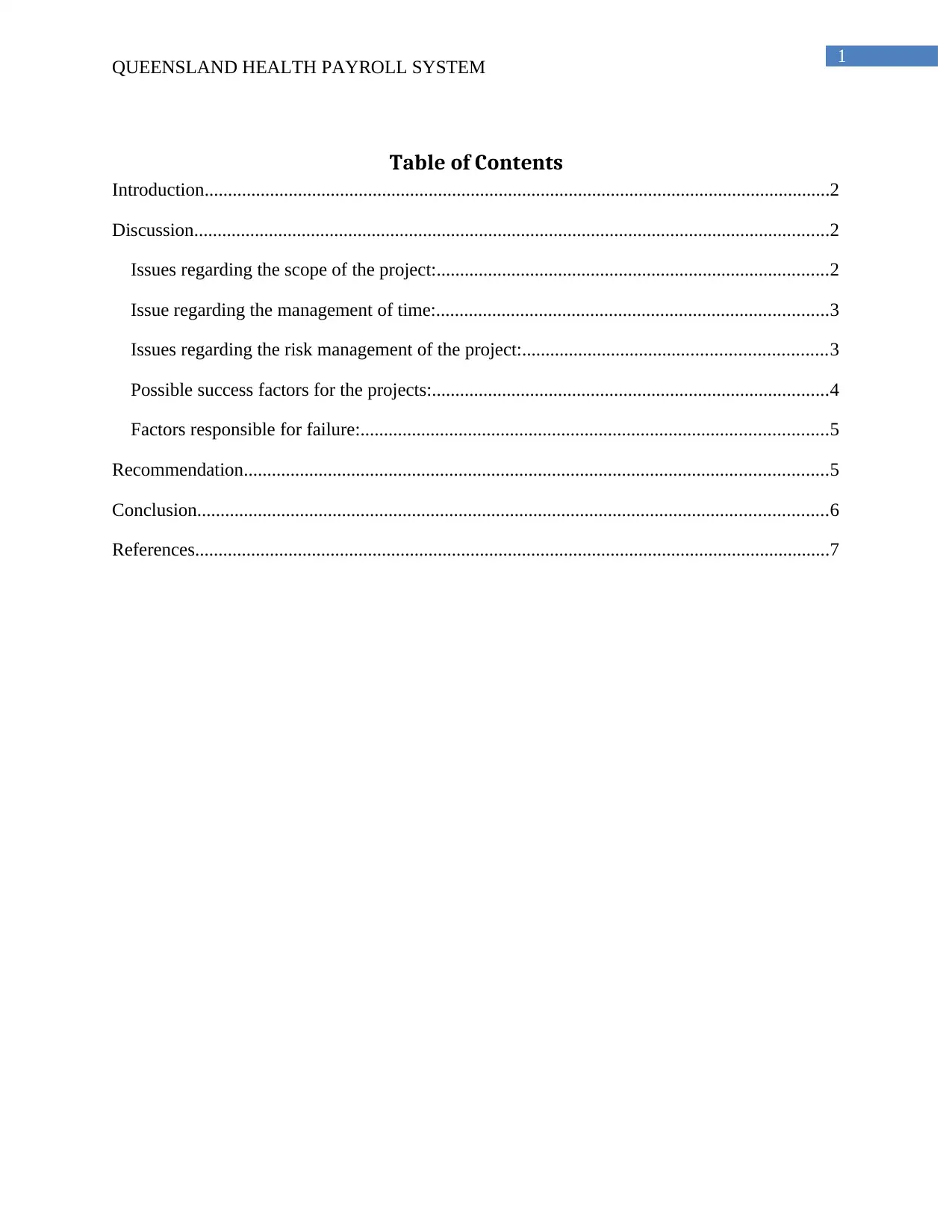
1
QUEENSLAND HEALTH PAYROLL SYSTEM
Table of Contents
Introduction......................................................................................................................................2
Discussion........................................................................................................................................2
Issues regarding the scope of the project:....................................................................................2
Issue regarding the management of time:....................................................................................3
Issues regarding the risk management of the project:.................................................................3
Possible success factors for the projects:.....................................................................................4
Factors responsible for failure:....................................................................................................5
Recommendation.............................................................................................................................5
Conclusion.......................................................................................................................................6
References........................................................................................................................................7
QUEENSLAND HEALTH PAYROLL SYSTEM
Table of Contents
Introduction......................................................................................................................................2
Discussion........................................................................................................................................2
Issues regarding the scope of the project:....................................................................................2
Issue regarding the management of time:....................................................................................3
Issues regarding the risk management of the project:.................................................................3
Possible success factors for the projects:.....................................................................................4
Factors responsible for failure:....................................................................................................5
Recommendation.............................................................................................................................5
Conclusion.......................................................................................................................................6
References........................................................................................................................................7
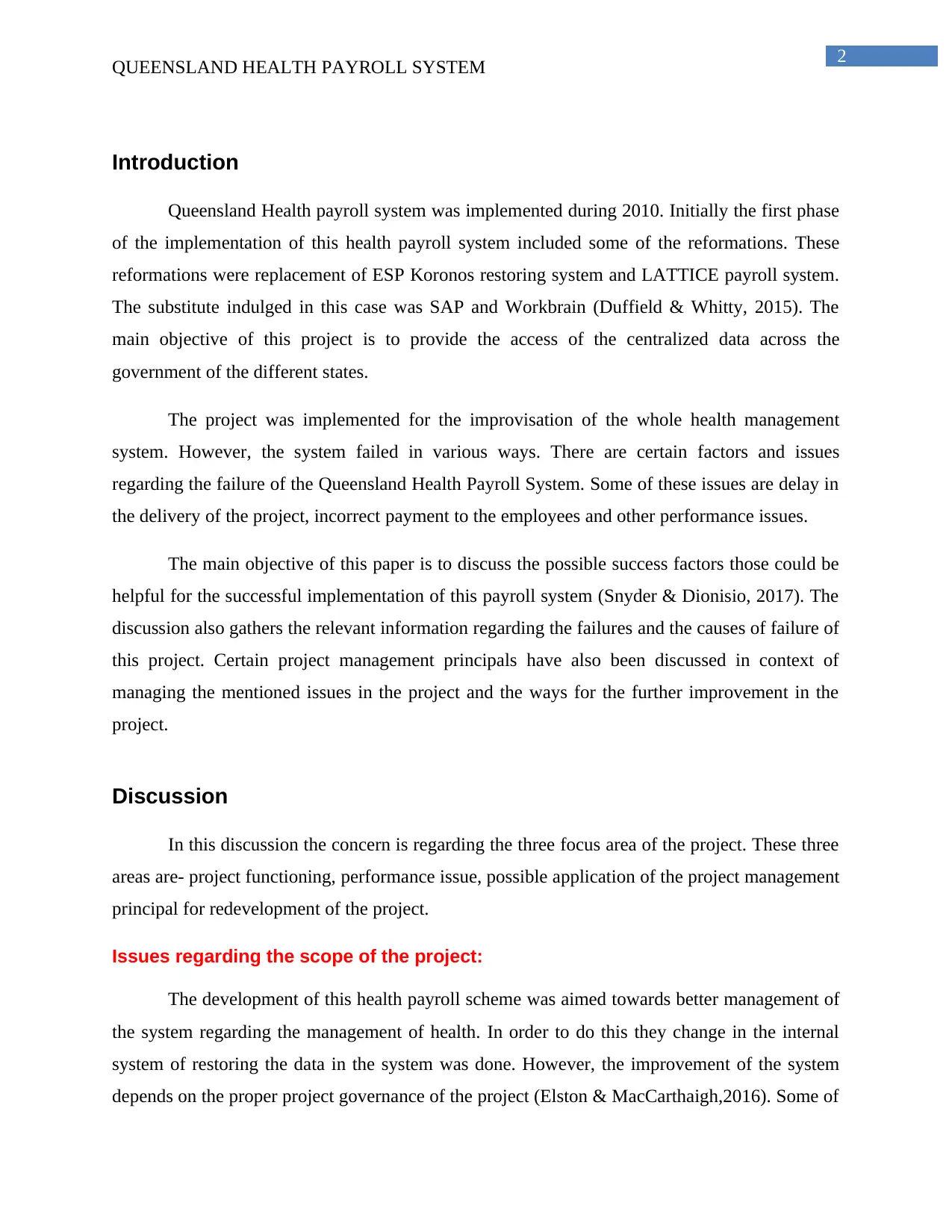
2
QUEENSLAND HEALTH PAYROLL SYSTEM
Introduction
Queensland Health payroll system was implemented during 2010. Initially the first phase
of the implementation of this health payroll system included some of the reformations. These
reformations were replacement of ESP Koronos restoring system and LATTICE payroll system.
The substitute indulged in this case was SAP and Workbrain (Duffield & Whitty, 2015). The
main objective of this project is to provide the access of the centralized data across the
government of the different states.
The project was implemented for the improvisation of the whole health management
system. However, the system failed in various ways. There are certain factors and issues
regarding the failure of the Queensland Health Payroll System. Some of these issues are delay in
the delivery of the project, incorrect payment to the employees and other performance issues.
The main objective of this paper is to discuss the possible success factors those could be
helpful for the successful implementation of this payroll system (Snyder & Dionisio, 2017). The
discussion also gathers the relevant information regarding the failures and the causes of failure of
this project. Certain project management principals have also been discussed in context of
managing the mentioned issues in the project and the ways for the further improvement in the
project.
Discussion
In this discussion the concern is regarding the three focus area of the project. These three
areas are- project functioning, performance issue, possible application of the project management
principal for redevelopment of the project.
Issues regarding the scope of the project:
The development of this health payroll scheme was aimed towards better management of
the system regarding the management of health. In order to do this they change in the internal
system of restoring the data in the system was done. However, the improvement of the system
depends on the proper project governance of the project (Elston & MacCarthaigh,2016). Some of
QUEENSLAND HEALTH PAYROLL SYSTEM
Introduction
Queensland Health payroll system was implemented during 2010. Initially the first phase
of the implementation of this health payroll system included some of the reformations. These
reformations were replacement of ESP Koronos restoring system and LATTICE payroll system.
The substitute indulged in this case was SAP and Workbrain (Duffield & Whitty, 2015). The
main objective of this project is to provide the access of the centralized data across the
government of the different states.
The project was implemented for the improvisation of the whole health management
system. However, the system failed in various ways. There are certain factors and issues
regarding the failure of the Queensland Health Payroll System. Some of these issues are delay in
the delivery of the project, incorrect payment to the employees and other performance issues.
The main objective of this paper is to discuss the possible success factors those could be
helpful for the successful implementation of this payroll system (Snyder & Dionisio, 2017). The
discussion also gathers the relevant information regarding the failures and the causes of failure of
this project. Certain project management principals have also been discussed in context of
managing the mentioned issues in the project and the ways for the further improvement in the
project.
Discussion
In this discussion the concern is regarding the three focus area of the project. These three
areas are- project functioning, performance issue, possible application of the project management
principal for redevelopment of the project.
Issues regarding the scope of the project:
The development of this health payroll scheme was aimed towards better management of
the system regarding the management of health. In order to do this they change in the internal
system of restoring the data in the system was done. However, the improvement of the system
depends on the proper project governance of the project (Elston & MacCarthaigh,2016). Some of
⊘ This is a preview!⊘
Do you want full access?
Subscribe today to unlock all pages.

Trusted by 1+ million students worldwide
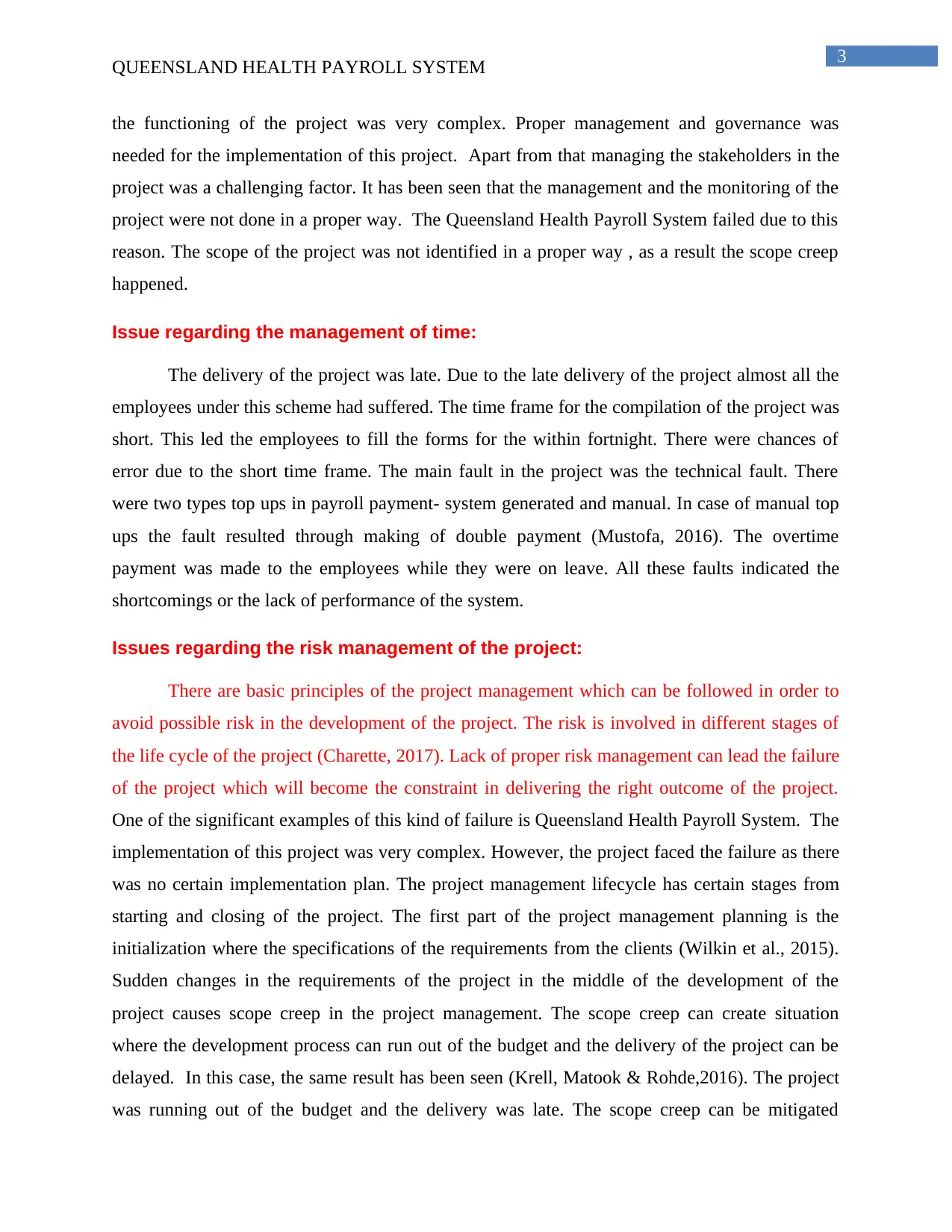
3
QUEENSLAND HEALTH PAYROLL SYSTEM
the functioning of the project was very complex. Proper management and governance was
needed for the implementation of this project. Apart from that managing the stakeholders in the
project was a challenging factor. It has been seen that the management and the monitoring of the
project were not done in a proper way. The Queensland Health Payroll System failed due to this
reason. The scope of the project was not identified in a proper way , as a result the scope creep
happened.
Issue regarding the management of time:
The delivery of the project was late. Due to the late delivery of the project almost all the
employees under this scheme had suffered. The time frame for the compilation of the project was
short. This led the employees to fill the forms for the within fortnight. There were chances of
error due to the short time frame. The main fault in the project was the technical fault. There
were two types top ups in payroll payment- system generated and manual. In case of manual top
ups the fault resulted through making of double payment (Mustofa, 2016). The overtime
payment was made to the employees while they were on leave. All these faults indicated the
shortcomings or the lack of performance of the system.
Issues regarding the risk management of the project:
There are basic principles of the project management which can be followed in order to
avoid possible risk in the development of the project. The risk is involved in different stages of
the life cycle of the project (Charette, 2017). Lack of proper risk management can lead the failure
of the project which will become the constraint in delivering the right outcome of the project.
One of the significant examples of this kind of failure is Queensland Health Payroll System. The
implementation of this project was very complex. However, the project faced the failure as there
was no certain implementation plan. The project management lifecycle has certain stages from
starting and closing of the project. The first part of the project management planning is the
initialization where the specifications of the requirements from the clients (Wilkin et al., 2015).
Sudden changes in the requirements of the project in the middle of the development of the
project causes scope creep in the project management. The scope creep can create situation
where the development process can run out of the budget and the delivery of the project can be
delayed. In this case, the same result has been seen (Krell, Matook & Rohde,2016). The project
was running out of the budget and the delivery was late. The scope creep can be mitigated
QUEENSLAND HEALTH PAYROLL SYSTEM
the functioning of the project was very complex. Proper management and governance was
needed for the implementation of this project. Apart from that managing the stakeholders in the
project was a challenging factor. It has been seen that the management and the monitoring of the
project were not done in a proper way. The Queensland Health Payroll System failed due to this
reason. The scope of the project was not identified in a proper way , as a result the scope creep
happened.
Issue regarding the management of time:
The delivery of the project was late. Due to the late delivery of the project almost all the
employees under this scheme had suffered. The time frame for the compilation of the project was
short. This led the employees to fill the forms for the within fortnight. There were chances of
error due to the short time frame. The main fault in the project was the technical fault. There
were two types top ups in payroll payment- system generated and manual. In case of manual top
ups the fault resulted through making of double payment (Mustofa, 2016). The overtime
payment was made to the employees while they were on leave. All these faults indicated the
shortcomings or the lack of performance of the system.
Issues regarding the risk management of the project:
There are basic principles of the project management which can be followed in order to
avoid possible risk in the development of the project. The risk is involved in different stages of
the life cycle of the project (Charette, 2017). Lack of proper risk management can lead the failure
of the project which will become the constraint in delivering the right outcome of the project.
One of the significant examples of this kind of failure is Queensland Health Payroll System. The
implementation of this project was very complex. However, the project faced the failure as there
was no certain implementation plan. The project management lifecycle has certain stages from
starting and closing of the project. The first part of the project management planning is the
initialization where the specifications of the requirements from the clients (Wilkin et al., 2015).
Sudden changes in the requirements of the project in the middle of the development of the
project causes scope creep in the project management. The scope creep can create situation
where the development process can run out of the budget and the delivery of the project can be
delayed. In this case, the same result has been seen (Krell, Matook & Rohde,2016). The project
was running out of the budget and the delivery was late. The scope creep can be mitigated
Paraphrase This Document
Need a fresh take? Get an instant paraphrase of this document with our AI Paraphraser
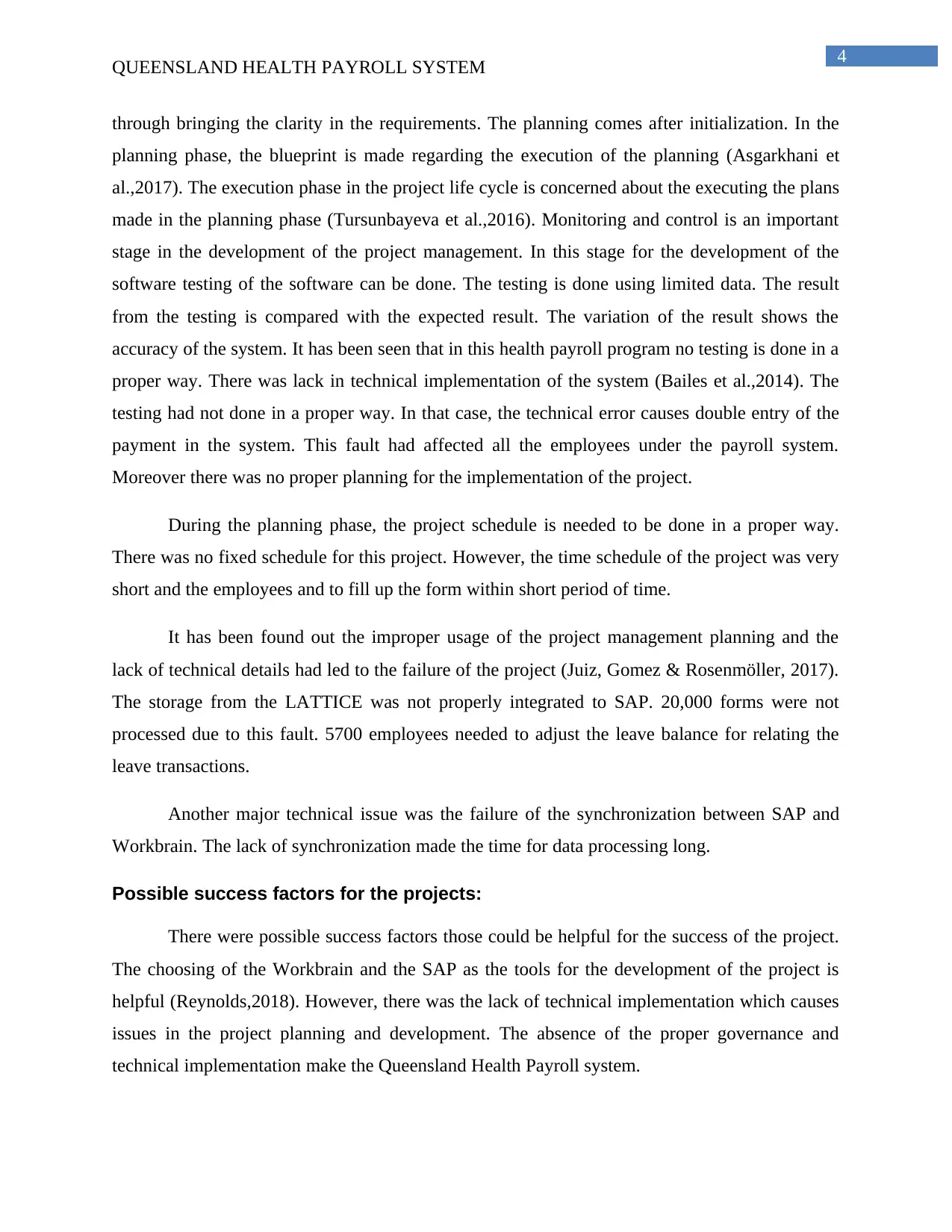
4
QUEENSLAND HEALTH PAYROLL SYSTEM
through bringing the clarity in the requirements. The planning comes after initialization. In the
planning phase, the blueprint is made regarding the execution of the planning (Asgarkhani et
al.,2017). The execution phase in the project life cycle is concerned about the executing the plans
made in the planning phase (Tursunbayeva et al.,2016). Monitoring and control is an important
stage in the development of the project management. In this stage for the development of the
software testing of the software can be done. The testing is done using limited data. The result
from the testing is compared with the expected result. The variation of the result shows the
accuracy of the system. It has been seen that in this health payroll program no testing is done in a
proper way. There was lack in technical implementation of the system (Bailes et al.,2014). The
testing had not done in a proper way. In that case, the technical error causes double entry of the
payment in the system. This fault had affected all the employees under the payroll system.
Moreover there was no proper planning for the implementation of the project.
During the planning phase, the project schedule is needed to be done in a proper way.
There was no fixed schedule for this project. However, the time schedule of the project was very
short and the employees and to fill up the form within short period of time.
It has been found out the improper usage of the project management planning and the
lack of technical details had led to the failure of the project (Juiz, Gomez & Rosenmöller, 2017).
The storage from the LATTICE was not properly integrated to SAP. 20,000 forms were not
processed due to this fault. 5700 employees needed to adjust the leave balance for relating the
leave transactions.
Another major technical issue was the failure of the synchronization between SAP and
Workbrain. The lack of synchronization made the time for data processing long.
Possible success factors for the projects:
There were possible success factors those could be helpful for the success of the project.
The choosing of the Workbrain and the SAP as the tools for the development of the project is
helpful (Reynolds,2018). However, there was the lack of technical implementation which causes
issues in the project planning and development. The absence of the proper governance and
technical implementation make the Queensland Health Payroll system.
QUEENSLAND HEALTH PAYROLL SYSTEM
through bringing the clarity in the requirements. The planning comes after initialization. In the
planning phase, the blueprint is made regarding the execution of the planning (Asgarkhani et
al.,2017). The execution phase in the project life cycle is concerned about the executing the plans
made in the planning phase (Tursunbayeva et al.,2016). Monitoring and control is an important
stage in the development of the project management. In this stage for the development of the
software testing of the software can be done. The testing is done using limited data. The result
from the testing is compared with the expected result. The variation of the result shows the
accuracy of the system. It has been seen that in this health payroll program no testing is done in a
proper way. There was lack in technical implementation of the system (Bailes et al.,2014). The
testing had not done in a proper way. In that case, the technical error causes double entry of the
payment in the system. This fault had affected all the employees under the payroll system.
Moreover there was no proper planning for the implementation of the project.
During the planning phase, the project schedule is needed to be done in a proper way.
There was no fixed schedule for this project. However, the time schedule of the project was very
short and the employees and to fill up the form within short period of time.
It has been found out the improper usage of the project management planning and the
lack of technical details had led to the failure of the project (Juiz, Gomez & Rosenmöller, 2017).
The storage from the LATTICE was not properly integrated to SAP. 20,000 forms were not
processed due to this fault. 5700 employees needed to adjust the leave balance for relating the
leave transactions.
Another major technical issue was the failure of the synchronization between SAP and
Workbrain. The lack of synchronization made the time for data processing long.
Possible success factors for the projects:
There were possible success factors those could be helpful for the success of the project.
The choosing of the Workbrain and the SAP as the tools for the development of the project is
helpful (Reynolds,2018). However, there was the lack of technical implementation which causes
issues in the project planning and development. The absence of the proper governance and
technical implementation make the Queensland Health Payroll system.
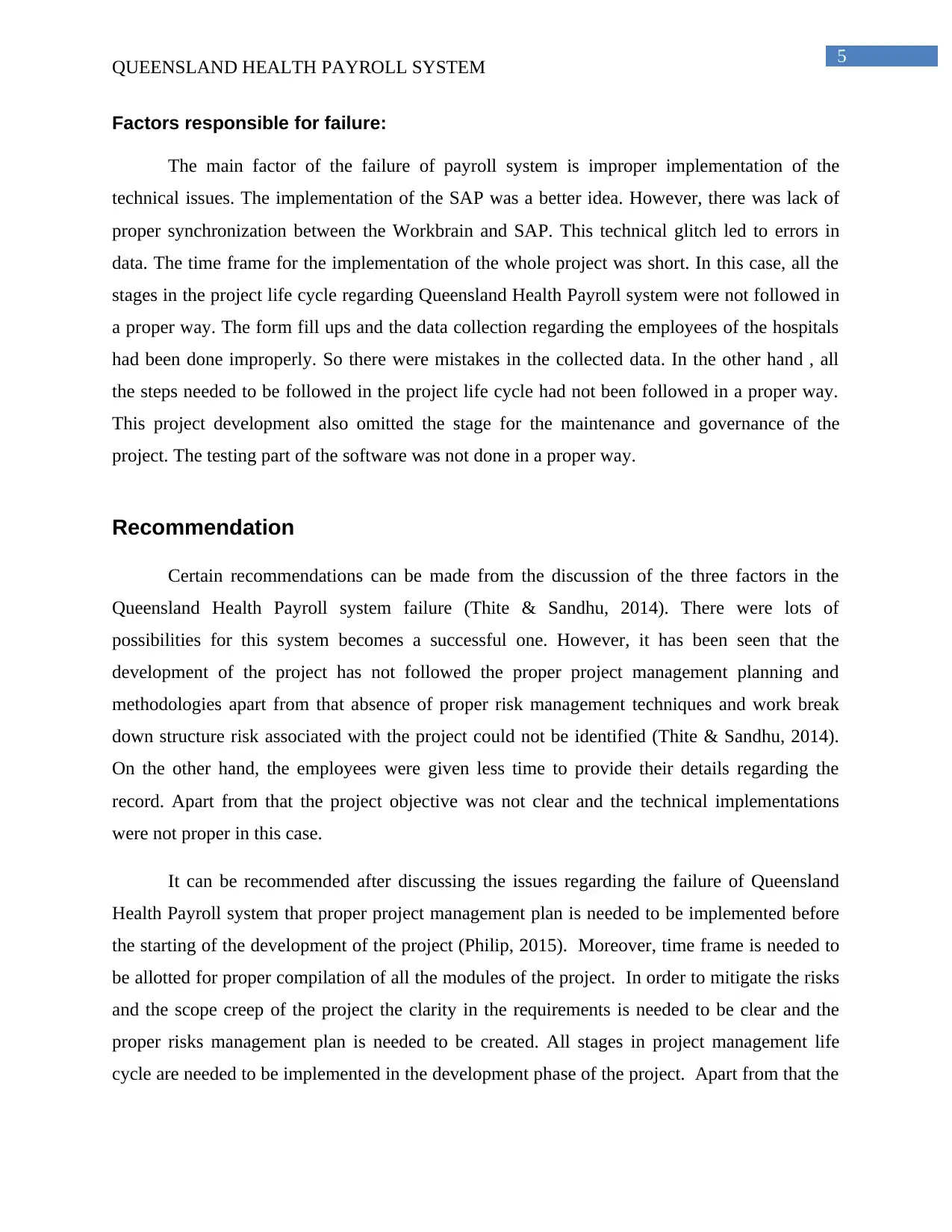
5
QUEENSLAND HEALTH PAYROLL SYSTEM
Factors responsible for failure:
The main factor of the failure of payroll system is improper implementation of the
technical issues. The implementation of the SAP was a better idea. However, there was lack of
proper synchronization between the Workbrain and SAP. This technical glitch led to errors in
data. The time frame for the implementation of the whole project was short. In this case, all the
stages in the project life cycle regarding Queensland Health Payroll system were not followed in
a proper way. The form fill ups and the data collection regarding the employees of the hospitals
had been done improperly. So there were mistakes in the collected data. In the other hand , all
the steps needed to be followed in the project life cycle had not been followed in a proper way.
This project development also omitted the stage for the maintenance and governance of the
project. The testing part of the software was not done in a proper way.
Recommendation
Certain recommendations can be made from the discussion of the three factors in the
Queensland Health Payroll system failure (Thite & Sandhu, 2014). There were lots of
possibilities for this system becomes a successful one. However, it has been seen that the
development of the project has not followed the proper project management planning and
methodologies apart from that absence of proper risk management techniques and work break
down structure risk associated with the project could not be identified (Thite & Sandhu, 2014).
On the other hand, the employees were given less time to provide their details regarding the
record. Apart from that the project objective was not clear and the technical implementations
were not proper in this case.
It can be recommended after discussing the issues regarding the failure of Queensland
Health Payroll system that proper project management plan is needed to be implemented before
the starting of the development of the project (Philip, 2015). Moreover, time frame is needed to
be allotted for proper compilation of all the modules of the project. In order to mitigate the risks
and the scope creep of the project the clarity in the requirements is needed to be clear and the
proper risks management plan is needed to be created. All stages in project management life
cycle are needed to be implemented in the development phase of the project. Apart from that the
QUEENSLAND HEALTH PAYROLL SYSTEM
Factors responsible for failure:
The main factor of the failure of payroll system is improper implementation of the
technical issues. The implementation of the SAP was a better idea. However, there was lack of
proper synchronization between the Workbrain and SAP. This technical glitch led to errors in
data. The time frame for the implementation of the whole project was short. In this case, all the
stages in the project life cycle regarding Queensland Health Payroll system were not followed in
a proper way. The form fill ups and the data collection regarding the employees of the hospitals
had been done improperly. So there were mistakes in the collected data. In the other hand , all
the steps needed to be followed in the project life cycle had not been followed in a proper way.
This project development also omitted the stage for the maintenance and governance of the
project. The testing part of the software was not done in a proper way.
Recommendation
Certain recommendations can be made from the discussion of the three factors in the
Queensland Health Payroll system failure (Thite & Sandhu, 2014). There were lots of
possibilities for this system becomes a successful one. However, it has been seen that the
development of the project has not followed the proper project management planning and
methodologies apart from that absence of proper risk management techniques and work break
down structure risk associated with the project could not be identified (Thite & Sandhu, 2014).
On the other hand, the employees were given less time to provide their details regarding the
record. Apart from that the project objective was not clear and the technical implementations
were not proper in this case.
It can be recommended after discussing the issues regarding the failure of Queensland
Health Payroll system that proper project management plan is needed to be implemented before
the starting of the development of the project (Philip, 2015). Moreover, time frame is needed to
be allotted for proper compilation of all the modules of the project. In order to mitigate the risks
and the scope creep of the project the clarity in the requirements is needed to be clear and the
proper risks management plan is needed to be created. All stages in project management life
cycle are needed to be implemented in the development phase of the project. Apart from that the
⊘ This is a preview!⊘
Do you want full access?
Subscribe today to unlock all pages.

Trusted by 1+ million students worldwide
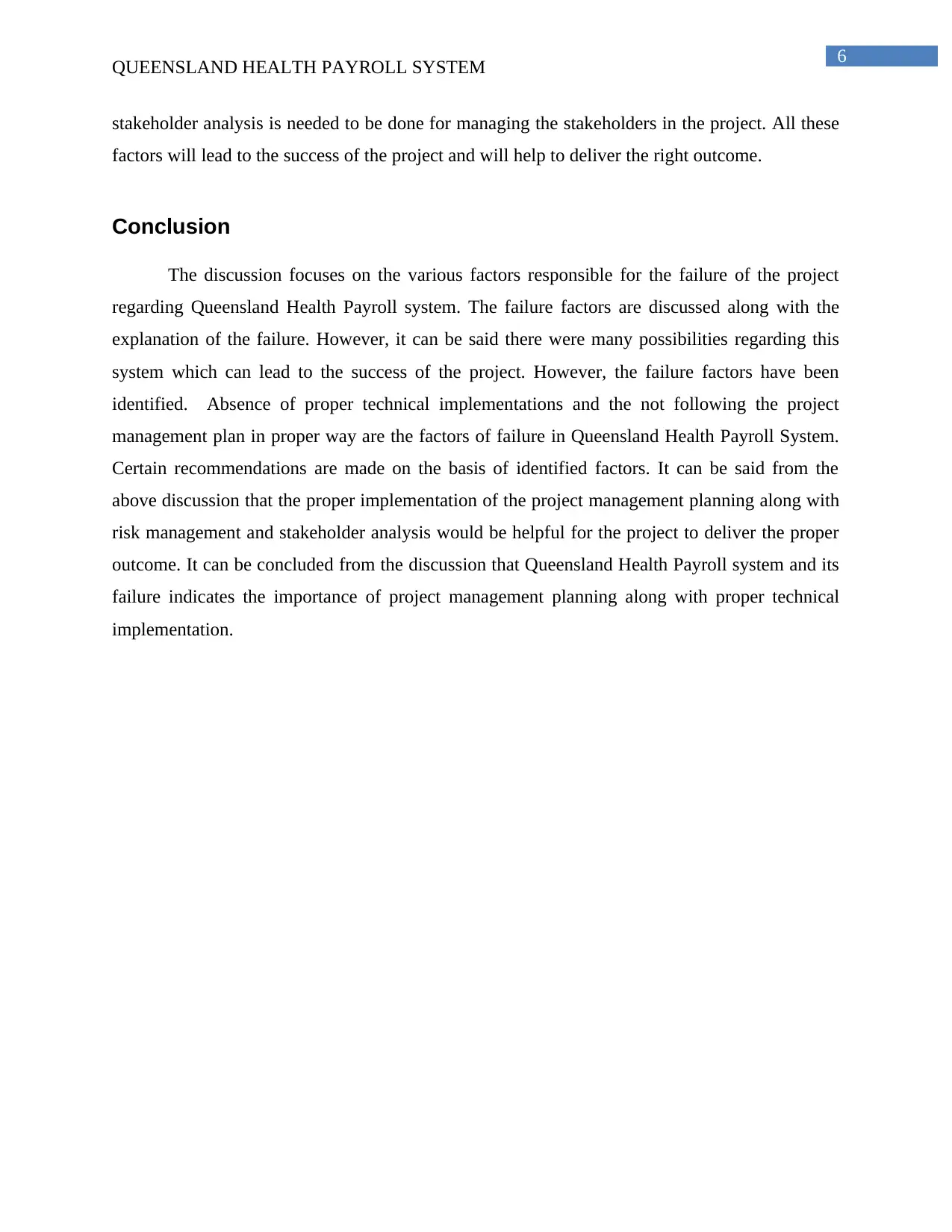
6
QUEENSLAND HEALTH PAYROLL SYSTEM
stakeholder analysis is needed to be done for managing the stakeholders in the project. All these
factors will lead to the success of the project and will help to deliver the right outcome.
Conclusion
The discussion focuses on the various factors responsible for the failure of the project
regarding Queensland Health Payroll system. The failure factors are discussed along with the
explanation of the failure. However, it can be said there were many possibilities regarding this
system which can lead to the success of the project. However, the failure factors have been
identified. Absence of proper technical implementations and the not following the project
management plan in proper way are the factors of failure in Queensland Health Payroll System.
Certain recommendations are made on the basis of identified factors. It can be said from the
above discussion that the proper implementation of the project management planning along with
risk management and stakeholder analysis would be helpful for the project to deliver the proper
outcome. It can be concluded from the discussion that Queensland Health Payroll system and its
failure indicates the importance of project management planning along with proper technical
implementation.
QUEENSLAND HEALTH PAYROLL SYSTEM
stakeholder analysis is needed to be done for managing the stakeholders in the project. All these
factors will lead to the success of the project and will help to deliver the right outcome.
Conclusion
The discussion focuses on the various factors responsible for the failure of the project
regarding Queensland Health Payroll system. The failure factors are discussed along with the
explanation of the failure. However, it can be said there were many possibilities regarding this
system which can lead to the success of the project. However, the failure factors have been
identified. Absence of proper technical implementations and the not following the project
management plan in proper way are the factors of failure in Queensland Health Payroll System.
Certain recommendations are made on the basis of identified factors. It can be said from the
above discussion that the proper implementation of the project management planning along with
risk management and stakeholder analysis would be helpful for the project to deliver the proper
outcome. It can be concluded from the discussion that Queensland Health Payroll system and its
failure indicates the importance of project management planning along with proper technical
implementation.
Paraphrase This Document
Need a fresh take? Get an instant paraphrase of this document with our AI Paraphraser
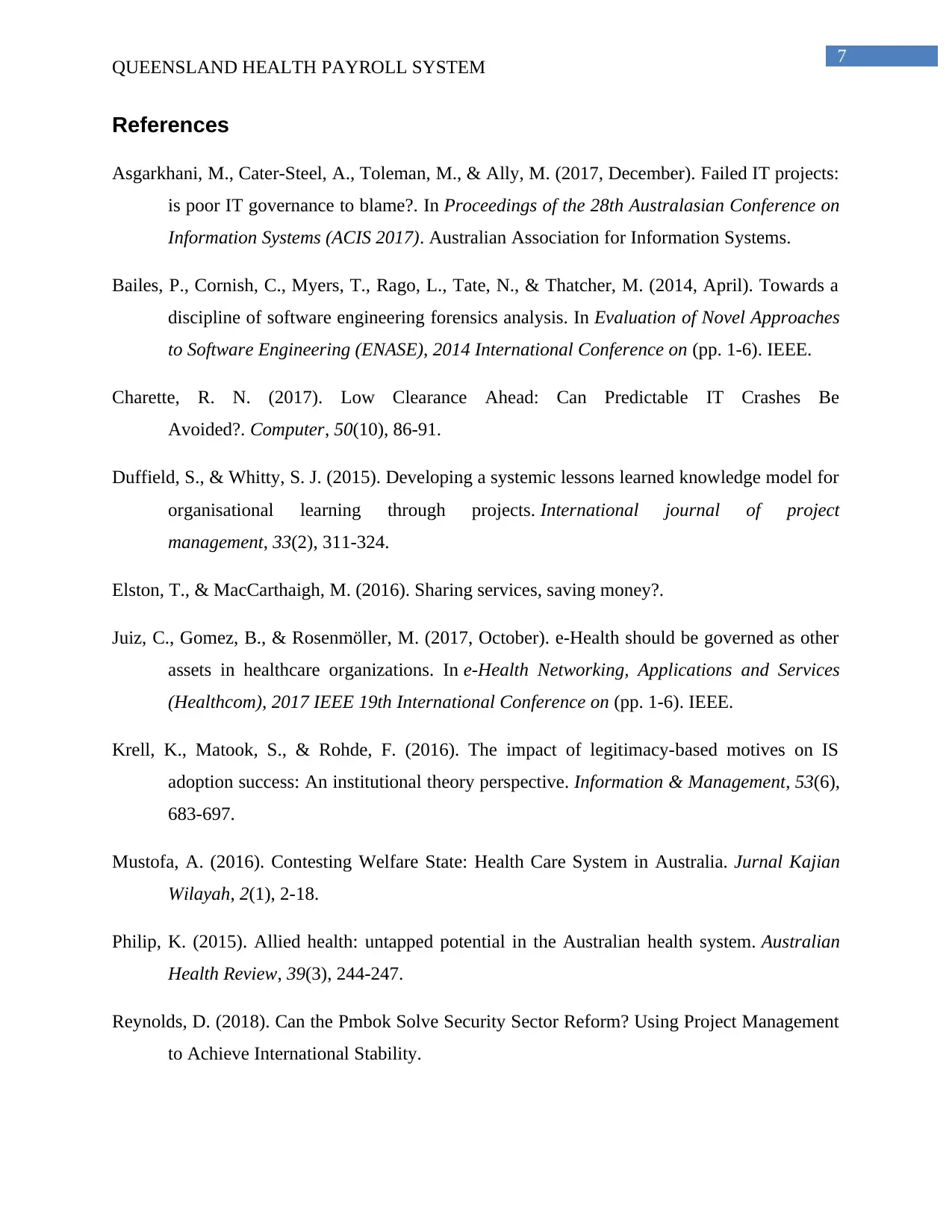
7
QUEENSLAND HEALTH PAYROLL SYSTEM
References
Asgarkhani, M., Cater-Steel, A., Toleman, M., & Ally, M. (2017, December). Failed IT projects:
is poor IT governance to blame?. In Proceedings of the 28th Australasian Conference on
Information Systems (ACIS 2017). Australian Association for Information Systems.
Bailes, P., Cornish, C., Myers, T., Rago, L., Tate, N., & Thatcher, M. (2014, April). Towards a
discipline of software engineering forensics analysis. In Evaluation of Novel Approaches
to Software Engineering (ENASE), 2014 International Conference on (pp. 1-6). IEEE.
Charette, R. N. (2017). Low Clearance Ahead: Can Predictable IT Crashes Be
Avoided?. Computer, 50(10), 86-91.
Duffield, S., & Whitty, S. J. (2015). Developing a systemic lessons learned knowledge model for
organisational learning through projects. International journal of project
management, 33(2), 311-324.
Elston, T., & MacCarthaigh, M. (2016). Sharing services, saving money?.
Juiz, C., Gomez, B., & Rosenmöller, M. (2017, October). e-Health should be governed as other
assets in healthcare organizations. In e-Health Networking, Applications and Services
(Healthcom), 2017 IEEE 19th International Conference on (pp. 1-6). IEEE.
Krell, K., Matook, S., & Rohde, F. (2016). The impact of legitimacy-based motives on IS
adoption success: An institutional theory perspective. Information & Management, 53(6),
683-697.
Mustofa, A. (2016). Contesting Welfare State: Health Care System in Australia. Jurnal Kajian
Wilayah, 2(1), 2-18.
Philip, K. (2015). Allied health: untapped potential in the Australian health system. Australian
Health Review, 39(3), 244-247.
Reynolds, D. (2018). Can the Pmbok Solve Security Sector Reform? Using Project Management
to Achieve International Stability.
QUEENSLAND HEALTH PAYROLL SYSTEM
References
Asgarkhani, M., Cater-Steel, A., Toleman, M., & Ally, M. (2017, December). Failed IT projects:
is poor IT governance to blame?. In Proceedings of the 28th Australasian Conference on
Information Systems (ACIS 2017). Australian Association for Information Systems.
Bailes, P., Cornish, C., Myers, T., Rago, L., Tate, N., & Thatcher, M. (2014, April). Towards a
discipline of software engineering forensics analysis. In Evaluation of Novel Approaches
to Software Engineering (ENASE), 2014 International Conference on (pp. 1-6). IEEE.
Charette, R. N. (2017). Low Clearance Ahead: Can Predictable IT Crashes Be
Avoided?. Computer, 50(10), 86-91.
Duffield, S., & Whitty, S. J. (2015). Developing a systemic lessons learned knowledge model for
organisational learning through projects. International journal of project
management, 33(2), 311-324.
Elston, T., & MacCarthaigh, M. (2016). Sharing services, saving money?.
Juiz, C., Gomez, B., & Rosenmöller, M. (2017, October). e-Health should be governed as other
assets in healthcare organizations. In e-Health Networking, Applications and Services
(Healthcom), 2017 IEEE 19th International Conference on (pp. 1-6). IEEE.
Krell, K., Matook, S., & Rohde, F. (2016). The impact of legitimacy-based motives on IS
adoption success: An institutional theory perspective. Information & Management, 53(6),
683-697.
Mustofa, A. (2016). Contesting Welfare State: Health Care System in Australia. Jurnal Kajian
Wilayah, 2(1), 2-18.
Philip, K. (2015). Allied health: untapped potential in the Australian health system. Australian
Health Review, 39(3), 244-247.
Reynolds, D. (2018). Can the Pmbok Solve Security Sector Reform? Using Project Management
to Achieve International Stability.
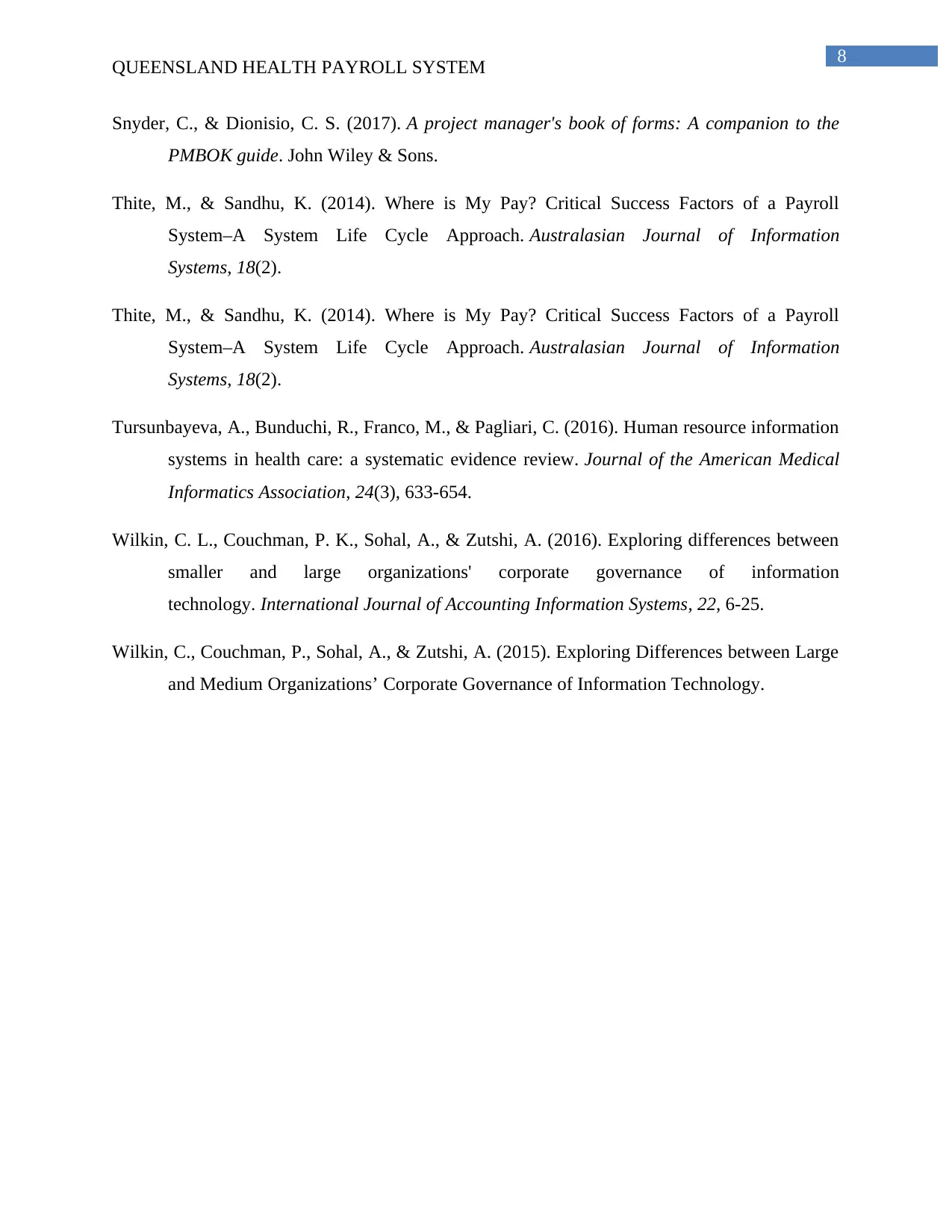
8
QUEENSLAND HEALTH PAYROLL SYSTEM
Snyder, C., & Dionisio, C. S. (2017). A project manager's book of forms: A companion to the
PMBOK guide. John Wiley & Sons.
Thite, M., & Sandhu, K. (2014). Where is My Pay? Critical Success Factors of a Payroll
System–A System Life Cycle Approach. Australasian Journal of Information
Systems, 18(2).
Thite, M., & Sandhu, K. (2014). Where is My Pay? Critical Success Factors of a Payroll
System–A System Life Cycle Approach. Australasian Journal of Information
Systems, 18(2).
Tursunbayeva, A., Bunduchi, R., Franco, M., & Pagliari, C. (2016). Human resource information
systems in health care: a systematic evidence review. Journal of the American Medical
Informatics Association, 24(3), 633-654.
Wilkin, C. L., Couchman, P. K., Sohal, A., & Zutshi, A. (2016). Exploring differences between
smaller and large organizations' corporate governance of information
technology. International Journal of Accounting Information Systems, 22, 6-25.
Wilkin, C., Couchman, P., Sohal, A., & Zutshi, A. (2015). Exploring Differences between Large
and Medium Organizations’ Corporate Governance of Information Technology.
QUEENSLAND HEALTH PAYROLL SYSTEM
Snyder, C., & Dionisio, C. S. (2017). A project manager's book of forms: A companion to the
PMBOK guide. John Wiley & Sons.
Thite, M., & Sandhu, K. (2014). Where is My Pay? Critical Success Factors of a Payroll
System–A System Life Cycle Approach. Australasian Journal of Information
Systems, 18(2).
Thite, M., & Sandhu, K. (2014). Where is My Pay? Critical Success Factors of a Payroll
System–A System Life Cycle Approach. Australasian Journal of Information
Systems, 18(2).
Tursunbayeva, A., Bunduchi, R., Franco, M., & Pagliari, C. (2016). Human resource information
systems in health care: a systematic evidence review. Journal of the American Medical
Informatics Association, 24(3), 633-654.
Wilkin, C. L., Couchman, P. K., Sohal, A., & Zutshi, A. (2016). Exploring differences between
smaller and large organizations' corporate governance of information
technology. International Journal of Accounting Information Systems, 22, 6-25.
Wilkin, C., Couchman, P., Sohal, A., & Zutshi, A. (2015). Exploring Differences between Large
and Medium Organizations’ Corporate Governance of Information Technology.
⊘ This is a preview!⊘
Do you want full access?
Subscribe today to unlock all pages.

Trusted by 1+ million students worldwide
1 out of 9
Related Documents
Your All-in-One AI-Powered Toolkit for Academic Success.
+13062052269
info@desklib.com
Available 24*7 on WhatsApp / Email
![[object Object]](/_next/static/media/star-bottom.7253800d.svg)
Unlock your academic potential
Copyright © 2020–2025 A2Z Services. All Rights Reserved. Developed and managed by ZUCOL.





